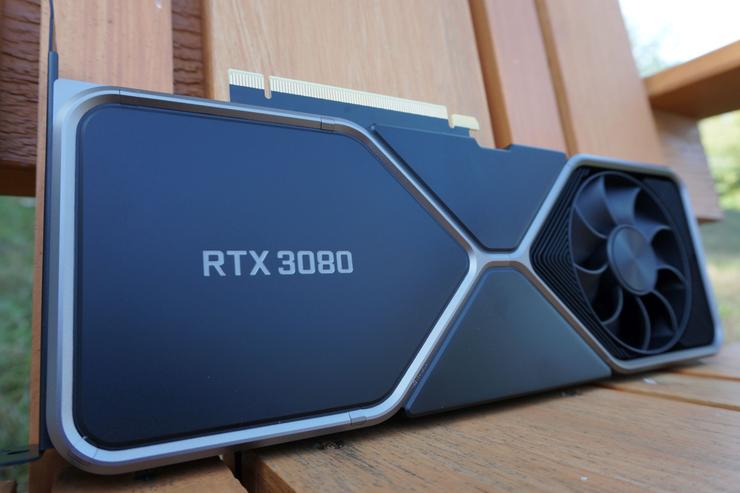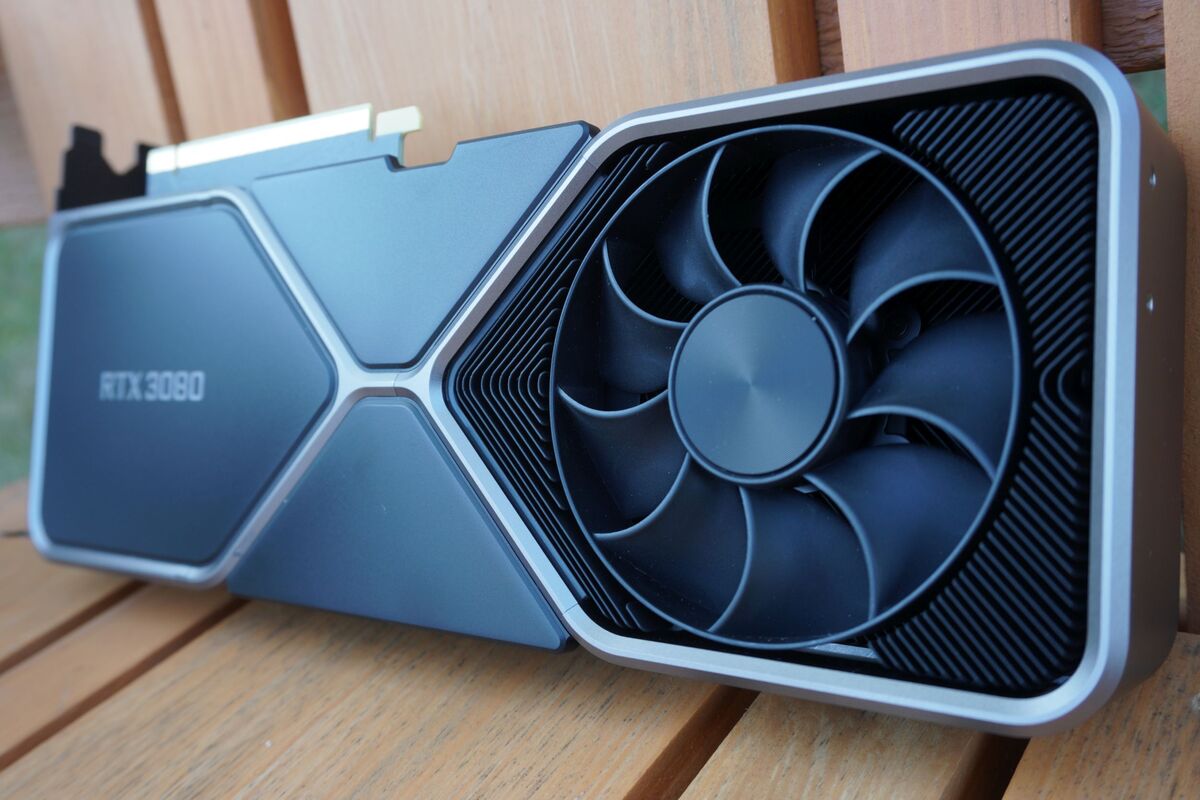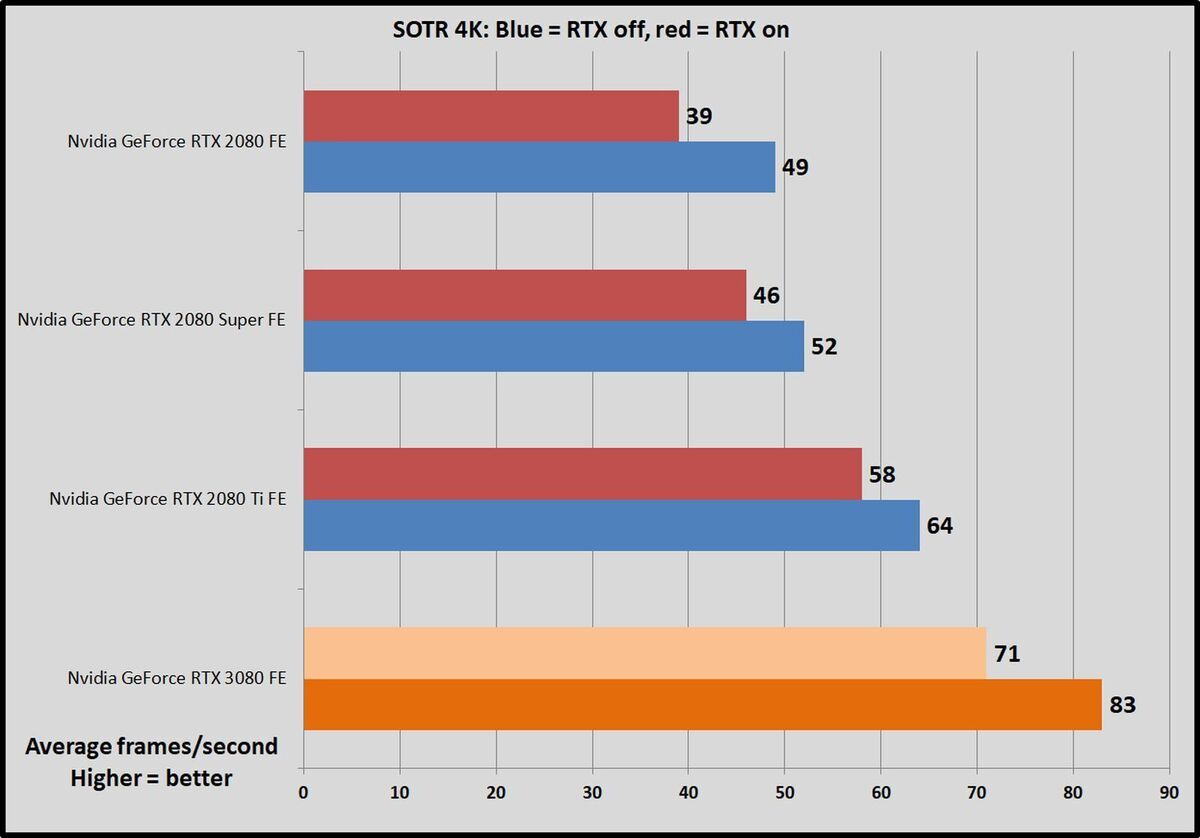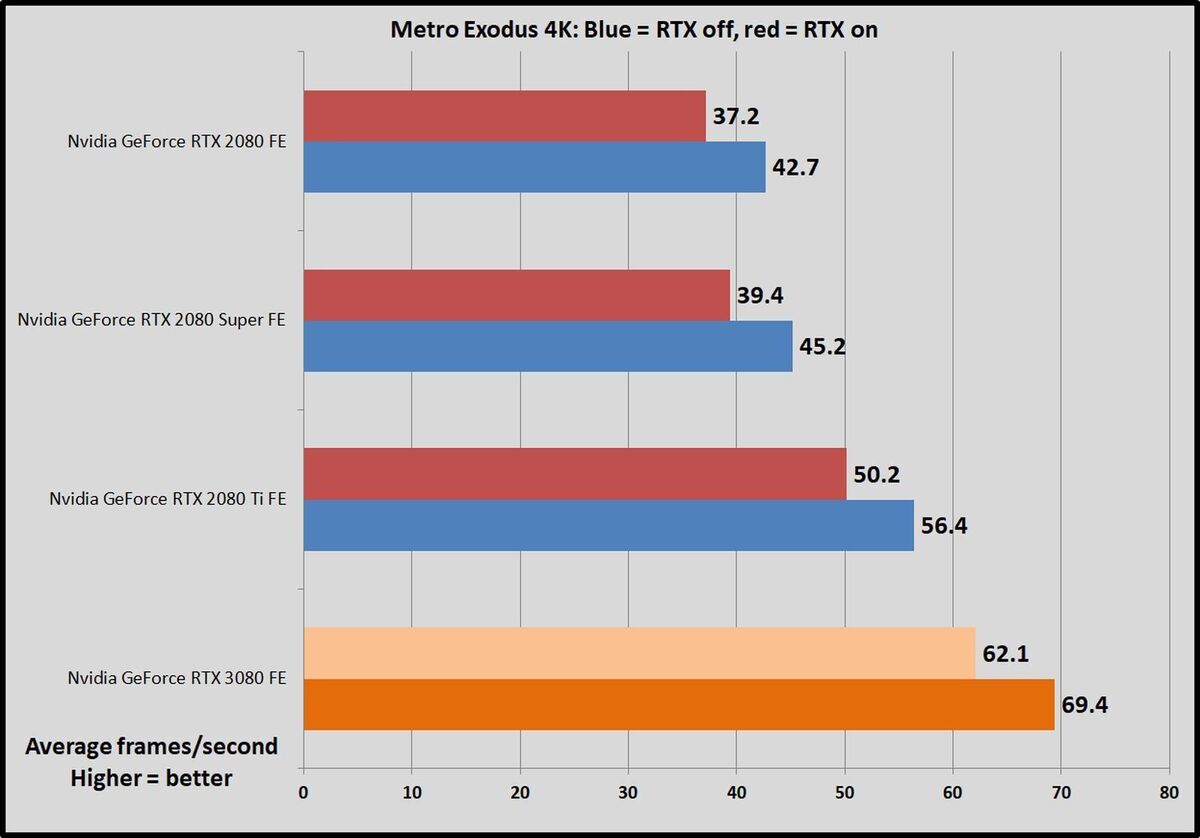 Credit: Brad Chacos/IDG
Credit: Brad Chacos/IDG
GeForce RTX 3080 ray tracing and DLSS benchmarks
 Brad Chacos/IDG
Brad Chacos/IDGTraditional gaming performance is only part of Nvidia’s value proposition with the GeForce RTX 3080. The company also packed this GPU with vastly improved RT and tensor core hardware to accelerate ray tracing and DLSS, respectively, now that those technologies are starting to gain more traction. Big-name games like Cyberpunk 2077, Watch Dogs Legion, and Vampire: The Masquerade—Bloodlines 2 will support ray tracing and DLSS as they roll out over the next few months. Fortnite is rolling out ray tracing, DLSS, and Nvidia Reflex on Thursday to roll out the red carpet for the RTX 3080’s launch.
[ Further reading: Nvidia RTX retrospective: What two years of ray tracing and DLSS got us ]
Ahead of the blitz, we benchmarked this card using compatible games in our suite to see if Nvidia’s lofty promises for the RTX 30-series proved true. We didn’t include the GTX 1080 and 1080 Ti in this section because, well, they don’t include dedicated ray tracing hardware. We hope to add more titles to this section in the future, so stay tuned.
First up: Shadow of the Tomb Raider. This was one of the first games to include ray tracing and the first incarnation of DLSS. The game’s ray traced shadows aren’t as breathtaking as Control’s multiple effects, but they could definitely impact performance on the original RTX 20-series GPUs, especially at the Ultra setting we test at. The first-gen DLSS implementation doesn’t support 1080p resolution, it’s worth noting—it bottoms out at 1920x1200. DLSS 2.0 is much more flexible.
 Brad Chacos/IDG
Brad Chacos/IDG Brad Chacos/IDG
Brad Chacos/IDGAt 4K, the performance impact of activating ray tracing and DLSS is a scant 14 percent on the new GeForce RTX 3080 FE. The card manages to stay well above 60 fps even with all those bells and whistles active. The RTX 2080, by comparison, can’t hit a consistent 40 fps with ray tracing and DLSS enabled, due to its hefty 26-percent performance penalty. Activating RTX impacts the 2080 Ti just 10 percent, meanwhile, which makes us wonder if memory capacity makes a difference with these features active. The RTX 2080 Ti has 1GB more capacity than the RTX 3080, albeit of the slower GDDR6 variety.
Metro Exodus was the second game ever to support ray tracing, but it remains one of the most impressive. Its ray-traced Global Illumination completely changes the vibe of the game, making it feel much more foreboding, ominous, and post-apocalyptic. It also uses the first incarnation of DLSS, which looks a lot better now than it did when the game first launched.
 Brad Chacos/IDG
Brad Chacos/IDG Brad Chacos/IDG
Brad Chacos/IDG Brad Chacos/IDG
Brad Chacos/IDGActivating ray tracing and DLSS makes the RTX 3080 FE run about 10 percent slower at 4K. That’s not bad at all to enable this sort of eye candy, and the average frame rate stays above the hallowed 60-fps mark.
Once again, its RTX 2080 predecessor fails to crack a 40-fps average, but its frame rate only suffers by about 13 percent with RTX on. It’s just that much slower in general performance.
The GeForce RTX 2080 Ti splits the difference with an 11-percent performance impact, but it can’t crack 60 fps even with ray tracing off at 4K. The frame rate impacts become much more pronounced at lower resolutions, where Nvidia says the CPU starts becoming a bigger factor in ray tracing performance. Still, Metro manages to hit a very nice 88-fps average at 1440p.
So much for not being able to play ray traced games at higher resolutions.
Finally, while the original version of DLSS could sometimes make games look a bit blurrier than native resolution, the fantastic DLSS 2.0 fixed that issue. It’s so good that some games are starting to include it even without ray tracing, including Death Stranding and the game we’re about to test, F1 2020. That’s because DLSS 2.0 can provide a boost in frame rates with little to no visual changes, depending on whether you use Quality or Performance mode. DLSS 2.0 is much easier to implement than the first version, and it’s such a game-changer that we hope to see more titles support it soon. Anywho, onto the benchmarks:
 Brad Chacos/IDG
Brad Chacos/IDG Brad Chacos/IDG
Brad Chacos/IDG Brad Chacos/IDG
Brad Chacos/IDGActivating DLSS 2.0 in F1 2020 gives the RTX 3080 an 18-percent frame rate boost at 4K, pushing its average close to 150 fps, while the RTX 2080 rides a 22-percent boost to almost 100 fps. The GeForce RTX 2080 Ti, meanwhile, sees a speedy 25-percent increase with DLSS active. The RTX 3080 sees much smaller boosts at lower resolutions, but that’s clearly because it’s nearing the frame rate limit of either the game engine or the CPU.
Nvidia touted vastly improved RT and tensor cores in the RTX 30-series. But as you can see, the older RTX 20-series cards manage to float in the same range of performance impact, aside from the RTX 2080’s major blow in Shadow of the Tomb Raider. Nvidia representatives told us that the amped-up RT and tensor cores can stretch their legs more in games with more strenuous ray tracing effects.
The best results should be seen in fully path-traced games like Minecraft RTX and Quake II RTX, Nvidia said. As triple-A games start integrating multiple ray tracing effects, the performance should grow compared to these early RTX titles with support for singular effects. Nvidia cited Control as a test-worthy example, but we weren’t able to benchmark that game in time for this review. Cyberpunk 2077 and Fortnite’s RTX update will also be absolutely loaded with various ray tracing technologies. We hope to benchmark RTX performance more soon.
Regardless, when it’s bolstered by DLSS, the GeForce RTX 3080 Founders Edition proves powerful enough to play with superb frame rates even with the penalty impact of ray tracing. That’s a major change from the RTX 20-series, where even the then-monstrous RTX 2080 Ti often needed to drop to 1440p or even 1080p to maintain 60 fps in ray traced games. If you upgrade to the RTX 3080, you needn’t be scared to turn on ray tracing anymore.
Next page: Power, thermals, and noise

















